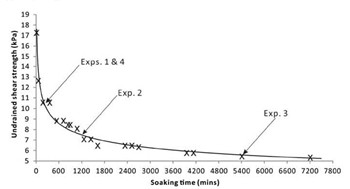Bedform genesis in bedrock substrates: Insights into formative processes from a new experimental approach and the importance of suspension-dominated abrasion
Bedrock channels are common in the natural environment, and bedrock channel erosion sets the pace of denudation in many river catchments. However, in comparison to the large number of studies concerning the formation of alluvial bedforms, relatively few investigations have concerned bedrock bedform genesis. Field-based analysis of sculptured forms within bedrock channels has been restricted notably by the slow rate of bedform development in such environments. Furthermore, only a limited number of flume-scale experiments have been conducted that attempt to simulate the genesis of sculpted bedforms in bedrock channels. This study demonstrates that optimization of clay beds through analysis of clay strength enables the development of features analogous to bedrock river channel bedforms — even at a scale that is orders of magnitude smaller than some natural examples. Three sets of suspended sediment-laden experiments were carried out using hard, medium, and soft clay bed substrates. A suite of erosive bedforms (including potholes, flutes, and furrows) developed on all experimental beds. All observed erosional features have clear equivalents to those observed in natural bedrock rivers. Bed shear strength was found to be a significant factor for the genesis of different types of simulated bedrock bedforms in our experiments with other factors, such as flow velocity, bed slope, and flow depth held approximately constant. Importantly, in a subset of experiments performed with an absence of suspended sediment, fluid flow did not result in the erosion and development of bedforms in the clay bed. Hence, this work illustrates that abrasion by suspended sediments is the key process required for the formation of these simulated bedrock bedforms in our experiments, in the absence of bedload abrasion; other processes such as plucking, cavitation, and dissolution will have been negligible.
Fig. 1. Schematic drawing of the current experimental setup of the hydraulic slurry flume. The dark area represents the clay bed with a tray that was lowered into position so that the top surface of the clay bed was flush with the surrounding false floor.
Fig. 2. Variation in undrained shear strength with soaking time. Positions of the initial undrained
shear strengths are shown for each experiment; Exps. 1 & 4: hard: 10.5 kPa; Exp. 2: medium: 7.5 kPa; Exp. 3: soft: 5.5 kPa.
shear strengths are shown for each experiment; Exps. 1 & 4: hard: 10.5 kPa; Exp. 2: medium: 7.5 kPa; Exp. 3: soft: 5.5 kPa.
List of relate publications:


